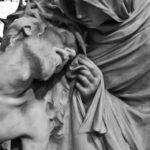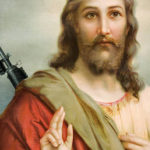We run our website the way we wished the whole internet worked: we provide high quality original content with no ads. We are funded solely by your direct support. Please consider supporting this project.

When God Endorsed Polygamy
We often find God acting as if he supports things we know, by other means, that he does not. For example, though his ideal was monogamy, it’s clear in the biblical narrative that, once God decided to permit men to acquire multiple wives and concubines, he was not above bearing the sin of his people by donning the mask of a deity who actually approves and even celebrates these things. To illustrate, in the course of Nathan chastising David for his affair with Bethsheba and for murdering her husband Uriah, the Lord is depicted as saying through the prophet Nathan:
I gave your master’s house to you, and your master’s wives into your arms. I gave you the house of Israel and Judah. And if all this had been too little, I would have given you even more (2 Sam. 12:8).
Yahweh here wears the mask of the deity who blessed David with multiple wives—indeed, with the wives that once belonged to his “master,” Saul—implying that Yahweh was the one who took them from Saul. Along the same lines, when it was time to announce David’s punishment, the Lord is depicted as saying through Nathan:
Out of your own household I am going to bring calamity on you. Before your very eyes I will take your wives and give them to one who is close to you, and he will sleep with your wives in broad daylight (2 Sam. 12:11).
Stooping to work within the culturally-conditioned and fallen framework of polygamy, and stooping, as well, to work in accordance with the system of immediate rewards and punishments that was the hallmark of God’s covenant with Israel, the Lord is portrayed as the one who was going to curse David by taking his wives and giving them to another man so that they would be raped “before [David’s] eyes” and “in broad daylight.” If we did not know better, these texts would lead us to conclude that Yahweh was a deity who not only had no problem with polygamy, he also had no problem using women as objects to “bless” favored men and to punish wayward men by having them raped in broad daylight!
While the author of this passage clearly embraced this barbaric conception of God, we who enjoy the full and complete revelation of God in Christ should suspect that something else is going on.
With our eyes fixed on Calvary, we must interpret this passage with the same depth perception of faith we have when we confess the crucified Christ to be the definitive Word of God. In this light, we may accept the portrait of God being enraged by David’s heinous sin to be direct revelation, for it is perfectly consistent with the revelation of God in Christ. But the same cannot be said of the violent and misogynistic actions that are attributed to this angry God, for it is simply impossible to imagine Christ causing women to be raped and publicly humiliated as a means of punishing their wayward husband. To this extent, therefore, this text should be understood to reflect the author’s culturally-conditioned, pen-ultimate perspective on God, which the humble God of covenantal love was nevertheless willing to step into as he “breathed” through him.
This does not mean that I deny that these women were tragically raped or that I otherwise assess this narrative to be fictional. I accept that this authoritative narrative intends to be treated as historical. It’s simply that I believe that in light of the cross, we must assess this narrative’s theological interpretation of how God was working through these events to reflect a penultimate perspective of God and to therefore function as an accommodating mask of God, depicting God as approving of activities, and engaging in activities, that he in fact finds repugnant. Yet, precisely as a mask, this narrative’s depiction of God is a shadow of the cross that points to a humble, God of cruciform love who is not above taking on an appearance that mirrors the fallen barbaric state of his people rather than that reflect his true, beautiful nature.
Image by Keoni Cabral via Flickr.
Category: General
Tags: Bible, Cruciform Theology, God
Topics: Interpreting Violent Pictures and Troubling Behaviors
Related Reading

Final Thoughts on Copan’s Critique of Crucifixion of the Warrior God
I want to sincerely thank Paul Copan for his well-researched critique of Crucifixion of the Warrior God (CWG) that I’ve been responding to over the last several weeks. He exposed areas in my work that needed buttressing up and/or clarifying, and he has helped introduce my ideas into the theological and philosophical marketplace of concepts…

The Problem with Christocentrism
As we’ve discussed in the previous posts, there has been a growing move toward a Christocentric orientation in theology since Barth, and especially over the last fifty years. I enthusiastically applaud this trend, for I’m persuaded it reflects the orientation of the NT itself, so far as it goes. The trouble is, it seems to…

Answering an Objection to a Cross-Centered Approach to Scripture
Through Greg’s Facebook and Twitter, we’ve been getting some great feedback and questions regarding his cross-centered approach to Scripture. Several have voiced questions similar to the reader’s (below), so we thought it would be helpful to post Greg’s answer here on his blog.

How Do You “See” God? God’s Self-Portrait, Part 1
When ReKnew first launched a year and a half ago, I planned on initially using the blog primarily to flesh out the theology and significance of the ReKnew Manifesto. As happens all-too-frequently in my ADHD world, that project got sidelined primary because of my obsession with finishing The Crucifixion of the Warrior God. Well, the…

God’s “Ways” and “Thoughts” are Higher
Isaiah 55:8-9 is one of the more often quoted passages in the Bible. It reads: … my thoughts are not your thoughts, neither are your ways my ways … As the heavens are higher than the earth, so are my ways higher than your ways and my thoughts than your thoughts (vss. 8-9). This…

Reflections on the Supremacy of Christ (Part 1)
In my previous post I argued that the Bible tells a story in which the culminating event – the coming of Christ – reframes everything that preceded it. Though it is all inspired, not everything in it should carry equal weight for us. Rather, everything leading up to Christ, including the portraits of God, must…
